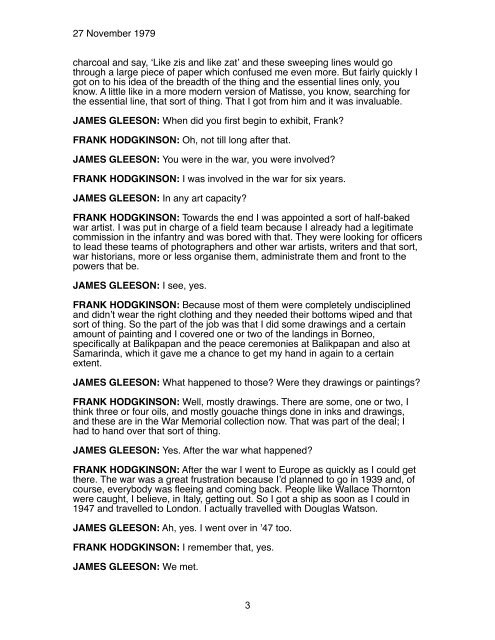frank hodgkinson - National Gallery of Australia
frank hodgkinson - National Gallery of Australia
frank hodgkinson - National Gallery of Australia
Create successful ePaper yourself
Turn your PDF publications into a flip-book with our unique Google optimized e-Paper software.
27 November 1979<br />
charcoal and say, ʻLike zis and like zatʼ and these sweeping lines would go<br />
through a large piece <strong>of</strong> paper which confused me even more. But fairly quickly I<br />
got on to his idea <strong>of</strong> the breadth <strong>of</strong> the thing and the essential lines only, you<br />
know. A little like in a more modern version <strong>of</strong> Matisse, you know, searching for<br />
the essential line, that sort <strong>of</strong> thing. That I got from him and it was invaluable.<br />
JAMES GLEESON: When did you first begin to exhibit, Frank?<br />
FRANK HODGKINSON: Oh, not till long after that.<br />
JAMES GLEESON: You were in the war, you were involved?<br />
FRANK HODGKINSON: I was involved in the war for six years.<br />
JAMES GLEESON: In any art capacity?<br />
FRANK HODGKINSON: Towards the end I was appointed a sort <strong>of</strong> half-baked<br />
war artist. I was put in charge <strong>of</strong> a field team because I already had a legitimate<br />
commission in the infantry and was bored with that. They were looking for <strong>of</strong>ficers<br />
to lead these teams <strong>of</strong> photographers and other war artists, writers and that sort,<br />
war historians, more or less organise them, administrate them and front to the<br />
powers that be.<br />
JAMES GLEESON: I see, yes.<br />
FRANK HODGKINSON: Because most <strong>of</strong> them were completely undisciplined<br />
and didnʼt wear the right clothing and they needed their bottoms wiped and that<br />
sort <strong>of</strong> thing. So the part <strong>of</strong> the job was that I did some drawings and a certain<br />
amount <strong>of</strong> painting and I covered one or two <strong>of</strong> the landings in Borneo,<br />
specifically at Balikpapan and the peace ceremonies at Balikpapan and also at<br />
Samarinda, which it gave me a chance to get my hand in again to a certain<br />
extent.<br />
JAMES GLEESON: What happened to those? Were they drawings or paintings?<br />
FRANK HODGKINSON: Well, mostly drawings. There are some, one or two, I<br />
think three or four oils, and mostly gouache things done in inks and drawings,<br />
and these are in the War Memorial collection now. That was part <strong>of</strong> the deal; I<br />
had to hand over that sort <strong>of</strong> thing.<br />
JAMES GLEESON: Yes. After the war what happened?<br />
FRANK HODGKINSON: After the war I went to Europe as quickly as I could get<br />
there. The war was a great frustration because Iʼd planned to go in 1939 and, <strong>of</strong><br />
course, everybody was fleeing and coming back. People like Wallace Thornton<br />
were caught, I believe, in Italy, getting out. So I got a ship as soon as I could in<br />
1947 and travelled to London. I actually travelled with Douglas Watson.<br />
JAMES GLEESON: Ah, yes. I went over in ʼ47 too.<br />
FRANK HODGKINSON: I remember that, yes.<br />
JAMES GLEESON: We met.<br />
3
















